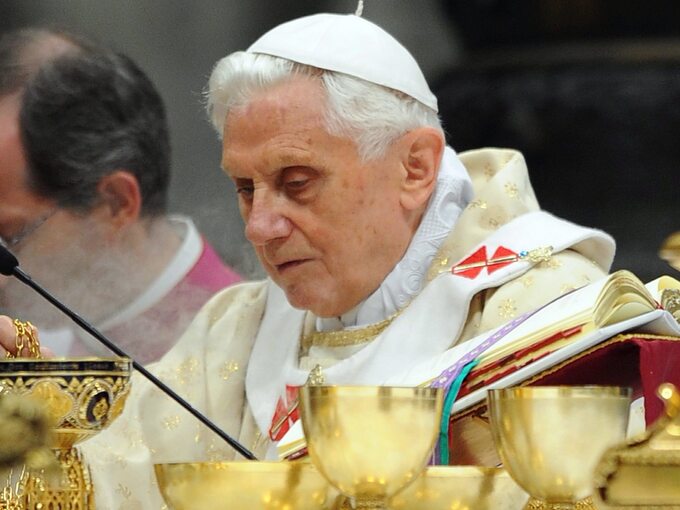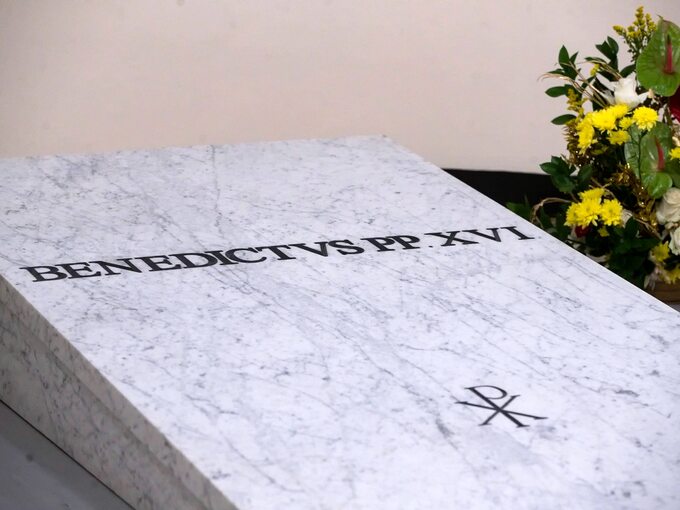Benedict XVI, due to his function as prefect of the Congregation for the Doctrine of the Faith before the pontificate, was sometimes perceived as a strict and inaccessible person. What was Pope Benedict really like?
War, workshop
Joseph Ratzinger was born on April 16, 1927 in Marktl (Bavaria), Germany, the son of Joseph, a town gendarme, and Maria, a cook. On the same day, he was baptized in the local parish. Joseph was the third child in the family; Maria and Georgy were born early. Ratzinger was very close to his siblings throughout his life: his brother later also became a priest, while his sister never married and was Joseph's housekeeper until her death in 1991.
When Joseph Ratzinger was 2 years old, the family moved to Tittmonning. After some time, he had to change his place of residence again – this time it became necessary because Joseph's father was persecuted by the Nazi Party for criticizing his demands. In 1932 the Ratizingers moved to Aschau am Inn. It was in this church that young Joseph Ratzinger experienced the beauty of the Holy Mass. It happened on Easter, during the Easter service. The church, whose windows were covered, was filled only when the priest sang a song about the resurrection of Christ. The dark temple, suddenly flooded with sunlight, became for the future pope the most eloquent symbol of Jesus' victory over death.
In 1937, the Ratzingers moved to Traunstein. The father of the family consistently opposed the Nazis, for which he was transferred several times and was forced to change his place of residence. The German Nazi authorities also punished his family for Ratzinger's attitude – the cousin of the future pope, suffering from Down syndrome, was forcibly taken by the Nazis for “therapy”, during which he was killed. This happened as part of the T4 operation carried out by the Nazis – the killing of futile and disabled people.

In Traunstein, young Joseph Ratzinger Jr. attended high school. He also learned to play the piano and was fascinated by Mozart. In 1939, Joseph entered the minor seminary of Traunstein. His brother was already studying in the same school. The future pope had to choose the path of the priesthood as a child. Apparently, at the age of 5, he told everyone that he would become a priest in the future – but few took his words seriously at the time. However, as it turned out, Ratzinger was very consistent in his decision.
Studying at the seminary was interrupted by the war between Germany and the USSR. The building where Ratzinger studied was converted into a military hospital. Joseph returned to high school. At that time, like all teenagers in Germany, he belonged to the Hitlerjugen – membership in this organization was mandatory.
At the age of 16, Joseph Ratzinger was sent to undergo military training in the field of air defense. Shortly after, he was transferred to the Reich Labor Service and sent to the Austro-Hungarian border. When Hungary was occupied by the Soviet Union, Ratzinger was sent home with his entire unit. In Traunstein, Ratzinger was assigned to the ground forces (infantry), but he was not sent to the front. In the last weeks of the war, like many other German soldiers, devastated by the impending defeat, he left the army and returned home.
After the Americans occupied his town, Ratzinger was taken prisoner. He was interned in a camp near Ulm and was released on June 19, 1945. Later that year, Joseph Ratzinger and his brother Georg entered the seminary again, this time at Freising. They also attended Ludwig-Maximilians University in Munich.
On June 29, 1951, Joseph Ratzinger was ordained a priest (George was also ordained on the same day). Two years later, Joseph defended his doctorate at St. Augustine, whose thought he had long been fascinated by (like St. Thomas Aquinas). The doctoral thesis of the future Pope was called: “People and the House of God in the Church's Doctrine of St. Augustine”. Four years later, Ratzinger wrote a thesis for his habilitation. His topic was the theology of history of St. Bonaventure. In 1958, Joseph Ratzinger became a professor at Freising College.
Joseph Ratzinger – Benedict XVI
In the late 1950s, Ratzinger became a professor at the University of Bonn. A few years later he also lectured, among others, at the Westphalian Wilhelm University in Münster. Joseph Ratzinger became one of the most famous theologians not only in Germany, but also abroad. In 1966, Ratzinger was appointed chairman of the dogmatic theology department at the Eberhard-Charles University of Tübingen. Since 1969 he has been lecturing at the University of Regensburg, and since 1972 he has been the editor of the theological magazine he founded. “Communion”.
Joseph Ratzinger argued that the Pope must listen to different voices coming from many sides of the Church. He was considered to be in favor of reforms, although he himself opposed the “modern” concepts of various priests. The 1960s were a time of Marxist moral revolution. Many priests, who preached the necessity of liberalizing the principles of faith, were also carried away by this “wave”. Ratzinger strongly disagreed with their demands, believing that the answer to the “sexual revolution” could not be a greater departure from traditional Catholic teaching, because such behavior would only further destroy the Church.

Joseph Ratzinger was consecrated Archbishop of Munich and Freising on March 25, 1977. His motto was “Cooperatores Veritatis”, meaning “Cooperators of Truth”. Soon after, on June 27, 1977, he became a cardinal.
John Paul II had great confidence in Ratzinger from the beginning of his pontificate. On November 25, 1981, Pope John Paul II appointed him prefect of the Congregation for the Doctrine of the Faith. From then until the death of John Paul II, it was Joseph Ratzinger who read and, when necessary, edited many of the writings and speeches of the Polish Pope.
Joseph Ratzinger was very active as prefect of the Congregation for the Doctrine of the Faith. He defended the traditional teachings of the Church and doctrine and opposed liberal “news” and unorthodox slogans and views. Ratzinger spoke critically against the liberation theology that found many supporters in Latin America in the 1980s. His opposition to this movement included, among other things: a report on the state of the faith. Ratzinger even received death threats after the publication of this work.
Joseph Ratzinger repeatedly spoke in defense of marriage, understood as the union of a man and a woman. He was against homosexual relationships and the adoption of children by such couples.
In addition to the prefecture, Joseph Ratzinger performed many functions. He was, among others, the chairman of the Pontifical Biblical Commission, the International Theological Commission, a member of the Congregation of the Oriental Churches and a member of the Congregation for the Discipline of Divine Worship and Communion. On November 30, 2002, he became Dean of the College of Cardinals. As a deacon, he began the funeral of the late John Paul II (April 8, 2005).

Joseph Ratzinger was chosen as the saint's successor. Peter and the next Pope John Paul II during the conclave on April 19, 2005. As Pope, he took the name Benedict XVI. He was the first German pope since the middle of the 11th century. Shortly after his election, when he appeared on the balcony of St. Peter's Basilica. Peter, Benedict XVI said:
“Dear brothers and sisters. After the great Pope John Paul II, the cardinals chose me – a simple, humble worker in the Lord's vineyard. I am comforted by the fact that the Lord knows how to use and work with imperfect tools, and above all I trust in your prayers. With the joy of the resurrected Lord, hoping for his constant help, we move forward. The Lord will help us and Mary, his holy mother, will stand by us. Thank you”.
Benedict XVI made 24 foreign trips during his pontificate. He also became known for his meetings with young people on World Youth Day. He also made 33 apostolic journeys to Italy.
The Pope is the author of three encyclicals: Caritas In Veritate (Love in Truth – encyclical on the integral development of man in love and truth), Spe Salvi (Saved in Hope – encyclical on Christian hope) and Deus Caritas Est (God is love). – Encyclical on Christian love). Joseph Ratzinger – Benedict XVI is also the author of more than 60 books and several hundred articles and theses.
As Pope, Benedict XVI restored the custom of using the papal throne, as well as wearing characteristic elements of clothing such as the cappello romano (saturno; hat), camauro or mozetta. The Pope also often drew attention to the outdoor setting of Holy Mass, which was supposed to be a beautiful, spiritual experience. He emphasized the need for priests to know the Latin language, urged them to use the Gregorian chant more often during liturgies and masses, and to take care of the purity and beauty of the church chant.
Benedict XVI sat on the throne of Peter for eight consecutive years. On February 11, 2013, he announced that as of February 28, 2013, he was leaving the service of the Bishop of Rome. On this day, February 28, 2013, at 8 pm, he ended his pontificate, left the Vatican and went to Castel Gandolfo. Benedict XVI's successor was Jorge Mario Bergoglio, who took the name Francis.
On May 2, 2013, Benedict XVI was installed in the Mater Ecclesiae monastery of the Vatican. He participated in several ceremonies with Pope Francis in the Vatican. He participated in the canonization of two Popes, John XXIII and John Paul II (April 27, 2014) and the beatification of Pope Paul VI (October 19, 2014).
Benedict XVI was the longest serving Pope in history. Joseph Ratzinger, Pope Benedict XVI died on December 31, 2022 at 9.34 in the Mater Ecclesiae monastery of the Vatican.
Also read:
A collection of personal homilies of Pope Benedict XVI will be published next yearAlso read:
Saint John the Apostle and Apocalypse IslandAlso read:
Archbishop Jakub Swinka. Against Germany, for the unity of Poland and the Church
(Tags Translate)Pope
